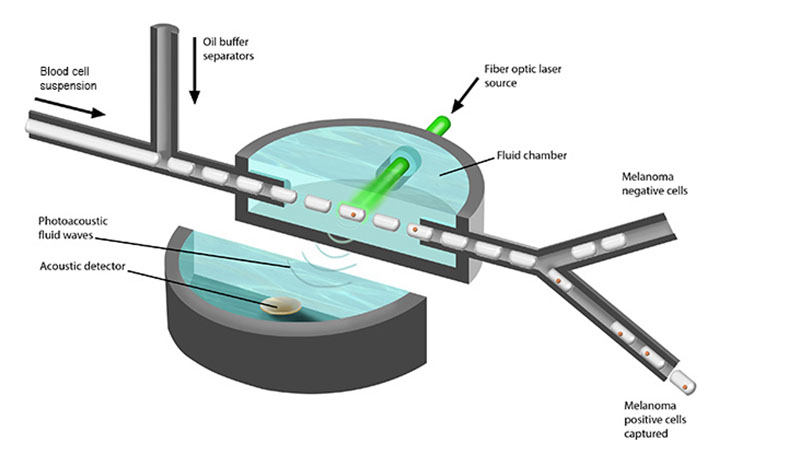A novel photoacoustic technique may enable doctors to detect the metastatic spread of cancer via the lymph and circulatory systems much earlier than previously possible, according to a proof-of-concept study, conducted by Acousys Biodevices. The study evaluated the predictive use of the Company’s photoacoustic flow cytometer technology to detect CTCs in blood samples from Stage III melanoma patients.
Circulating tumor cells are recognized as indicators of metastatic spread of cancer via the lymph and circulatory systems. Detection of metastases at a cellular level could potentially improve outcomes by supporting earlier treatment or more personalized patient care plans. Current imaging diagnostics require tumor formation of several millimeters before detection, which could equate to several months of undetectable growth.

Acousys Biodevices’ photoacoustic detector. Image courtesy of Acousys Biodevices.
The pilot proof-of-concept study tested blood samples, taken at the time of diagnosis, from 14 Stage III melanoma patients with surgically-resected high-risk disease who remained disease free or relapsed within two years of follow-up. The researchers used the Acousys photoacoustic flow cytometer to target pigmented circulating melanoma cells in which a laser pulse induced ultrasonic signatures in the melanoma cells, while not affecting the healthy cells. Only pigmented cells absorbed the laser light, resulting in photoacoustic waves which were detected by an acoustic transducer. The photoacoustic flow cytometer then counted and captured cells that generated photoacoustic waves. Results, which reached statistical significance (p-value = 0.1), accurately predicted the metastatic progression in the sample patients. Of the 8 patients who remained disease free, 2 had CMCs, 6 didn’t. Of those who became metastatic, 5 had CMCs, 1 didn’t.
“The data suggests we have a strong prognostic tool which warrants further testing for its ability to accurately detect early metastasis, capture intact CTCs and guide the management of advanced stage melanoma patients, as well as its potential use with other types of cancer where circulating tumor cells are known to be important predictors of metastatic disease, such as cancers of the pancreas, breast, and lung,” said abstract lead author and Chief Scientific Officer of Acousys Biodevices, John A. Viator, Ph.D. “With our photoacoustic technology, we aim to usher in a new era of therapy in which advanced cancer is fought cell by cell, rather than against large, macroscopic tumors as is current practice.”
“A predictive diagnostic able to qualify and capture circulating tumor cells would have field-shifting benefits and allow clinicians an opportunity to make earlier therapeutic adjustments in the setting of resistance or progression,” commented Mark S. Cohen, MD, FACS, Associate Chair in Surgery for Innovation, Associate Professor of Surgery and Pharmacology, University of Michigan Health System.
The proof-of-concept study, authored by John Viator, Ph. D., Chief Scientific Officer, Acousys Biodevices, will be presented at the annual conference of the American Society of Clinical Oncology (ASCO.) A link to the abstract can be obtained by clicking here.
